Introduction Letter To Parents From Teacher
[Your School's Letterhead]
[Date]
Dear Parents and Guardians,
I hope this letter finds you well. As we embark on a new academic year, I am excited and honored to introduce myself as your child's [Grade Level] teacher at [School Name]. It is with great enthusiasm that I welcome you to our classroom community.
My name is [Your Name], and I am committed to providing your child with a nurturing and engaging learning environment. I hold a [Your Degree] in [Your Field] from [Your University], and I bring [X] years of teaching experience to the classroom. Education is not just my profession; it is my passion. I am dedicated to fostering a love for learning, promoting critical thinking, and helping each student reach their fullest potential.
In our classroom, we will focus on creating a safe and inclusive space where every student feels valued and respected. Open communication is essential, and I encourage you to reach out to me with any questions, concerns, or insights you may have. I believe that a strong partnership between home and school is key to your child's success.
Throughout the year, your child will have the opportunity to explore a wide range of subjects, develop important skills, and participate in various engaging activities. I am committed to tailoring our lessons to accommodate different learning styles and abilities, ensuring that each student can thrive and grow.
I will be regularly updating you on your child's progress, both academically and socially. We will have parent-teacher conferences and regular communication through emails and newsletters. Additionally, I encourage you to attend school events and be an active part of our school community.
I am genuinely looking forward to getting to know each of your children and helping them reach new heights in their educational journey. I believe that with your support and collaboration, we can create a positive and impactful school year for all.
Thank you for entrusting me with your child's education. I am excited to embark on this educational journey together. Please feel free to contact me at [Your Email] or [Your Phone Number] if you have any questions or if there is anything you would like to discuss.
Warmest regards,
[Your Name]
[Your Title]
[Grade Level]
[School Name]
[Contact Information]
Welcome Back to School - New Academic Year
Dear Parents and Families,
Welcome to what promises to be an exciting and enriching academic year! I'm thrilled to introduce myself as your child's teacher and share my enthusiasm for the learning journey ahead.
My name is [Teacher Name], and I bring [number] years of experience in elementary education, with a particular passion for [subject area/grade level]. I believe that every child has unique strengths and potential, and my goal is to create a nurturing environment where your child can thrive academically, socially, and emotionally.
This year, we'll be exploring fascinating topics including [brief curriculum overview]. I'm excited to incorporate hands-on activities, collaborative projects, and creative approaches to learning that will engage and challenge your child.
Communication between home and school is vital to your child's success. I encourage you to reach out with any questions, concerns, or insights about your child. You can contact me via email at [email] or through our classroom app. I'll be sending weekly updates about our classroom activities and your child's progress.
I look forward to meeting you at our upcoming Back-to-School Night on [date] and building a strong partnership throughout the year.
Warm regards,
[Teacher Name]
Mid-Year Teacher Transfer Introduction
Dear Parents,
I hope this message finds you and your family well. I am writing to introduce myself as your child's new teacher, effective [date]. I understand that changes during the school year can be concerning, and I want to assure you of my commitment to providing continuity and excellence in your child's education.
My name is [Teacher Name], and I have been teaching for [number] years, with extensive experience in [grade level/subject]. I've carefully reviewed each student's progress and learning needs with [previous teacher's name] to ensure a smooth transition.
I recognize that building trust and rapport takes time, and I am dedicated to getting to know your child's individual learning style, interests, and needs. Over the next few weeks, I'll be observing, assessing, and connecting with each student to maintain their academic momentum.
Please don't hesitate to schedule a meeting with me to discuss your child's specific needs, concerns, or goals. I believe that open communication is essential, especially during transitions.
I'm excited about the opportunity to be part of your child's educational journey and look forward to working together.
Sincerely,
[Teacher Name]
Substitute Teacher Extended Assignment
Dear Families,
I hope this email finds you well. My name is [Teacher Name], and I will be serving as your child's substitute teacher for an extended period while [regular teacher's name] is [away/on leave]. I wanted to reach out personally to introduce myself and outline my plans for maintaining educational continuity.
I bring [number] years of teaching experience in [relevant areas] and am fully committed to upholding the high standards and positive classroom environment your child is accustomed to. I have been working closely with [regular teacher's name] to understand the curriculum, classroom routines, and individual student needs.
During my time with your class, I will continue following the established lesson plans while bringing my own expertise and enthusiasm to the learning experience. I believe in maintaining consistency while also introducing fresh perspectives that can enhance your child's education.
I understand that having a substitute teacher for an extended time may raise questions or concerns. Please feel free to contact me at [email] or [phone] to discuss anything related to your child's experience in our classroom.
I'm looking forward to working with your child and being a positive part of their educational journey during this time.
Best regards,
[Teacher Name]
First-Year Teacher Introduction
Dear Parents and Guardians,
Hello! I'm absolutely thrilled to introduce myself as your child's teacher for this school year. This is my first year as a professional educator, and I couldn't be more excited to begin this journey with your amazing children.
My name is [Teacher Name], and I recently graduated from [University] with my degree in [Education Field]. While I may be new to the profession, I bring fresh energy, current educational training, and an unwavering passion for helping children learn and grow.
During my student teaching experience at [school], I discovered my love for [specific aspects of teaching]. I've spent the summer preparing engaging lessons, setting up our classroom environment, and learning about each of your children from their previous teachers.
I know you might have questions about entrusting your child to a first-year teacher, and I want you to know that I don't take this responsibility lightly. I'm supported by an incredible team of veteran educators and am committed to continuous learning and improvement.
I welcome your patience as I navigate this first year, and I promise to bring enthusiasm, dedication, and genuine care to every day with your children. Please don't hesitate to share insights about your child's learning needs, interests, or any concerns you might have.
Looking forward to an amazing year together!
Enthusiastically yours,
[Teacher Name]
Returning Teacher After Extended Leave
Dear Families,
I hope this letter finds you well. I'm excited to write to you as I prepare to return to the classroom after my extended leave. I have missed teaching tremendously and am eager to reconnect with the wonderful students and families in our school community.
For those who may not know me, I'm [Teacher Name], and I taught [grade/subject] for [number] years before taking leave for [brief, appropriate reason - maternity, medical, etc.]. During my time away, I've been in regular contact with the substitute teacher and have been following your children's progress closely.
I want to express my gratitude to [substitute teacher's name] for maintaining the high standards and positive learning environment during my absence. The transition back should be smooth, as I've been kept informed of all curriculum developments and individual student progress.
I'm refreshed and excited to bring new ideas and renewed energy to our classroom. I've used my time away to reflect on teaching practices and am looking forward to implementing some exciting new approaches to learning.
Please feel free to reach out if you have any questions about the transition or if there's anything specific about your child's recent experiences that you'd like me to know.
I can't wait to see the students again and continue our learning journey together!
Warmly,
[Teacher Name]
Specialized Program Teacher Introduction
Dear Parents,
Greetings! I'm delighted to introduce myself as the [specific program] teacher who will be working with your child this year. My name is [Teacher Name], and I specialize in providing targeted educational support for students with [specific needs/abilities].
I hold certifications in [relevant certifications] and have [number] years of experience working with students who have unique learning profiles. I'm passionate about creating individualized learning experiences that challenge and support each child according to their specific needs and abilities.
Your child has been recommended for our [program name] based on [brief, positive explanation of selection criteria]. This program is designed to [explain program goals and methods in parent-friendly language]. We'll be working both in small group settings and through push-in support in the regular classroom.
I believe strongly in collaboration between home and school. I'll be communicating regularly with both you and your child's classroom teacher to ensure we're providing consistent, comprehensive support. You can expect [frequency] updates on your child's progress and strategies you can use at home.
I'm also available for conferences whenever you feel they would be beneficial. Understanding your child's interests, challenges, and learning style from your perspective is invaluable to creating the most effective educational experience.
Looking forward to working with your child and supporting their unique educational journey!
Best regards,
[Teacher Name]
Certified [Relevant Certification]
Emergency Classroom Change Notification
Dear Parents,
I am writing to inform you of an unexpected change that will affect your child's classroom assignment. Due to [brief, appropriate explanation - enrollment changes, facility issues, etc.], your child will be transitioning to my classroom effective [date].
I understand that sudden changes can be unsettling for both children and parents, and I want to assure you that we are taking every step to make this transition as smooth as possible. My name is [Teacher Name], and I have [number] years of experience teaching [grade level].
Here's what you need to know:
- Your child's new classroom location: [details]
- Any changes to pickup/drop-off procedures: [details]
- New classroom supply needs: [details if any]
- Timeline for the transition: [specific dates and steps]
I have been working closely with [previous teacher] to understand each child's academic progress, social needs, and individual learning style. All academic records, assessments, and individualized learning plans will transfer seamlessly.
I recognize this change may raise concerns, and I welcome the opportunity to discuss how we can best support your child during this transition. Please don't hesitate to contact me at [contact information] or schedule a brief meeting.
Thank you for your understanding and flexibility during this adjustment period.
Sincerely,
[Teacher Name]
What is an Introduction Letter to Parents from Teacher and Why is it Important
An introduction letter to parents from a teacher is a formal or informal communication that establishes the first connection between educator and families. This letter serves multiple critical purposes: building trust and rapport, setting expectations for the academic year, providing essential contact information, and demonstrating the teacher's commitment to student success. These letters are particularly crucial because they create the foundation for ongoing home-school collaboration, which research consistently shows improves student outcomes. The letter also helps parents feel informed and involved from the very beginning, reducing anxiety about their child's new educational environment.
Who Should Send Introduction Letters to Parents
- New teachers starting their first year or first position at a school
- Veteran teachers beginning with a new grade level or class
- Substitute teachers taking on long-term assignments (more than 2-3 weeks)
- Specialized program teachers (gifted education, special education, ESL, resource teachers)
- Teachers returning from extended leaves (maternity, medical, sabbatical)
- Department heads or team leaders introducing curriculum changes
- Teachers involved in emergency classroom changes or unexpected reassignments
- Student teachers who will be leading the classroom independently
- Co-teachers in collaborative classroom settings
When Should Introduction Letters be Sent to Parents
- 2-3 weeks before school starts for new academic year introductions
- Within 24-48 hours of any mid-year teacher changes or emergency reassignments
- Immediately upon assignment for long-term substitute positions
- 1 week before returning from extended leave to allow preparation time
- At the beginning of new semester for teachers taking over mid-year
- Before major curriculum changes or program implementations
- After winter or spring breaks when new teachers join mid-year
- Following any significant classroom structure changes or relocations
- Upon assignment to specialized programs regardless of timing in school year
How to Write and Send Introduction Letters to Parents
- Research your audience: Learn about the school community, demographics, and communication preferences
- Gather necessary information: Student roster, curriculum overview, school policies, contact protocols
- Choose appropriate tone: Match the school culture while maintaining authenticity
- Draft multiple versions if needed for different situations (new vs. returning families)
- Include essential contact information and preferred communication methods
- Proofread carefully for grammar, spelling, and professional presentation
- Send through school-approved channels: Email systems, parent portals, or physical mail
- Follow up to ensure receipt and address any immediate concerns
- Coordinate timing with school administration and other teachers
- Keep copies for documentation and future reference
Requirements and Prerequisites Before Sending Introduction Letters
- School administration approval for content and timing
- Access to parent contact information through official school systems
- Understanding of school communication policies and required disclaimers
- Knowledge of student privacy laws (FERPA compliance)
- Familiarity with school culture and expectations
- Completion of any required training for new teachers
- Review of previous year's records and student information
- Coordination with grade level teams for consistent messaging
- Understanding of diverse family needs including language barriers
- Preparation of follow-up communication plans
- Knowledge of emergency contact protocols and procedures
Formatting Guidelines for Introduction Letters
- Length: Keep between 250-500 words for optimal readability
- Tone: Professional yet warm and approachable
- Structure: Clear introduction, body with key information, positive closing
- Contact information: Multiple ways to reach you with response timeframes
- Subject line (for emails): Clear and specific like "Introduction from Your Child's New Teacher"
- Font and layout: Professional, easy-to-read formatting
- Language considerations: Simple, jargon-free language; translations if needed
- Personalization: Reference specific grade, subject, or program when possible
- School branding: Include school letterhead or official formatting when required
- Digital vs. print: Choose format based on school preference and family access
Follow-up Actions After Sending Introduction Letters
- Monitor responses and reply promptly to parent inquiries or concerns
- Schedule individual meetings for parents who request them
- Send reminder communications if initial response rate is low
- Update school administration on any issues or concerns raised
- Document parent preferences for future communication
- Prepare for Back-to-School night or similar events with personalized talking points
- Create backup communication plans for non-responsive families
- Follow up with struggling or special needs students' families for additional support
- Coordinate with school counselors if emotional or social concerns arise
- Plan ongoing communication schedule based on initial responses
Common Mistakes to Avoid in Introduction Letters
- Being too generic without school or grade-specific details
- Overwhelming parents with too much information in the first communication
- Using educational jargon that parents may not understand
- Forgetting to include contact information or preferred communication methods
- Being overly casual or overly formal for the school culture
- Making promises you cannot keep about student outcomes or experiences
- Sharing inappropriate personal information or oversharing
- Sending letters too early or too late relative to school calendar
- Ignoring cultural sensitivity in language or assumptions
- Failing to proofread for errors that undermine professionalism
- Not coordinating with team members leading to conflicting messages
Advantages and Disadvantages of Sending Introduction Letters
Advantages:
- Establishes positive first impression and builds trust early
- Reduces parent anxiety about new teacher or classroom changes
- Opens communication channels before problems arise
- Demonstrates professionalism and commitment to student success
- Provides essential information in writing for future reference
- Shows respect for parents as partners in education
Disadvantages:
- Time-consuming to write and personalize effectively
- May create unrealistic expectations if promises cannot be kept
- Could overwhelm parents with information early in relationship
- Might highlight inexperience if teacher is new to profession
- May not reach all families due to communication barriers
- Could create pressure to maintain constant communication
Essential Elements and Structure of Introduction Letters
- Professional greeting addressing parents appropriately
- Clear self-introduction with name, credentials, and experience
- Teaching philosophy or approach briefly explained
- Curriculum overview or subject focus areas
- Communication preferences and contact information
- Availability for meetings or conferences
- Positive expectations for student success and partnership
- Next steps or upcoming events (Back-to-School Night, etc.)
- Professional closing with signature and title
- School contact information as backup
- Any required school disclaimers or legal notices
Tips and Best Practices for Effective Introduction Letters
- Start writing early to allow time for revision and approval
- Keep student needs central rather than focusing solely on teacher qualifications
- Use specific examples of teaching approaches or classroom activities
- Include a call to action like attending school events or scheduling meetings
- Show cultural awareness and sensitivity to diverse family structures
- Mention classroom technology or communication apps parents will need
- Reference school resources and support systems available
- Express genuine enthusiasm for working with students and families
- Provide clear expectations for parent involvement and communication
- End on a positive, forward-looking note that builds excitement for the year ahead
Comparison with Other School Communications
Introduction letters differ from other school communications in several key ways. Unlike newsletters which focus on ongoing activities, introduction letters establish initial relationships and set foundational expectations. They're more personal than school-wide announcements but less detailed than progress reports. Compared to informal meet-and-greet events, letters provide written reference material parents can review multiple times. Unlike emergency notifications, introduction letters allow time for thoughtful composition and revision. They serve as relationship-building tools rather than information-delivery mechanisms like permission slips or policy updates. The tone is typically warmer than disciplinary communications but more professional than casual classroom updates.
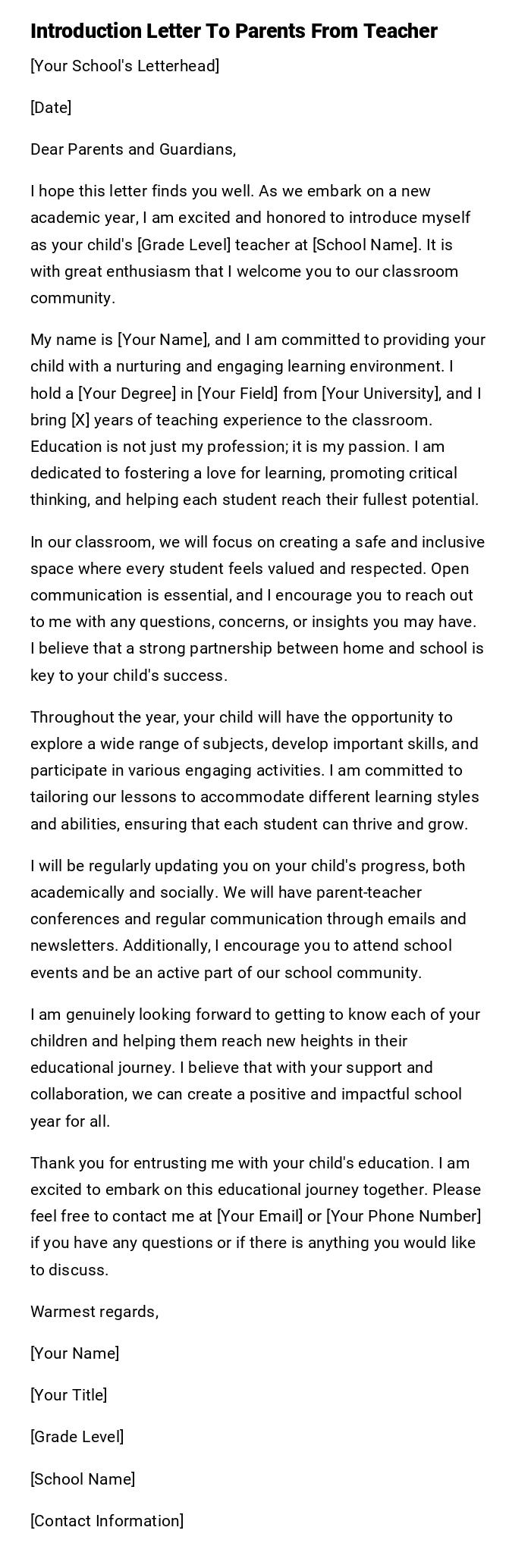
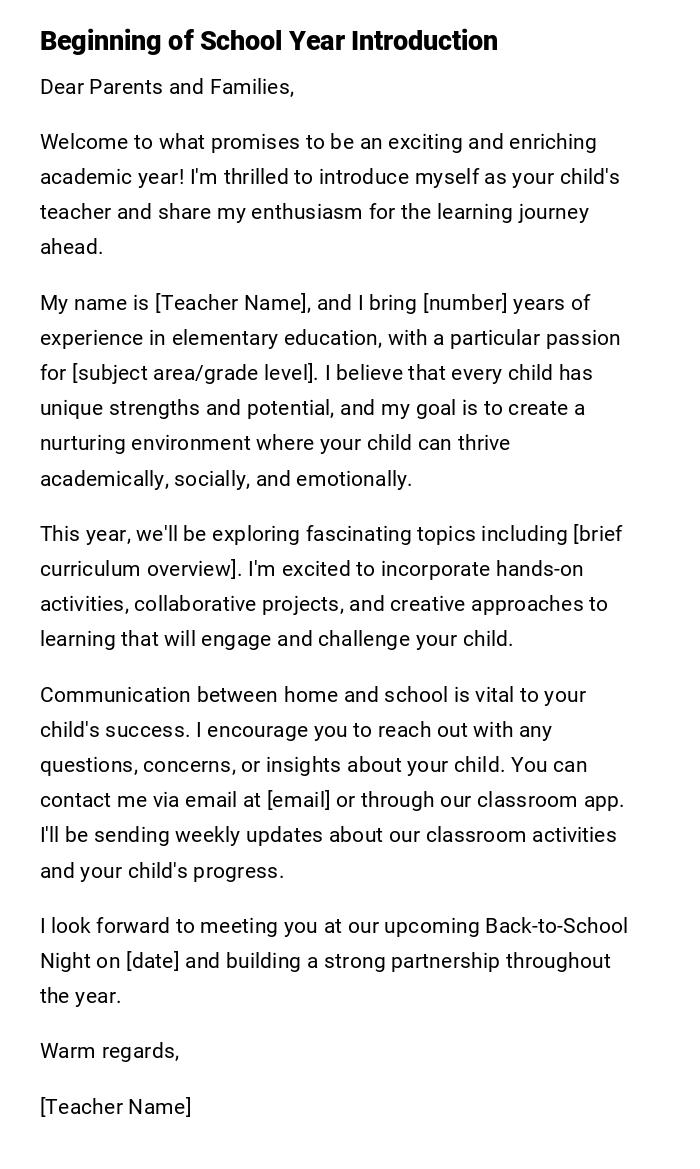
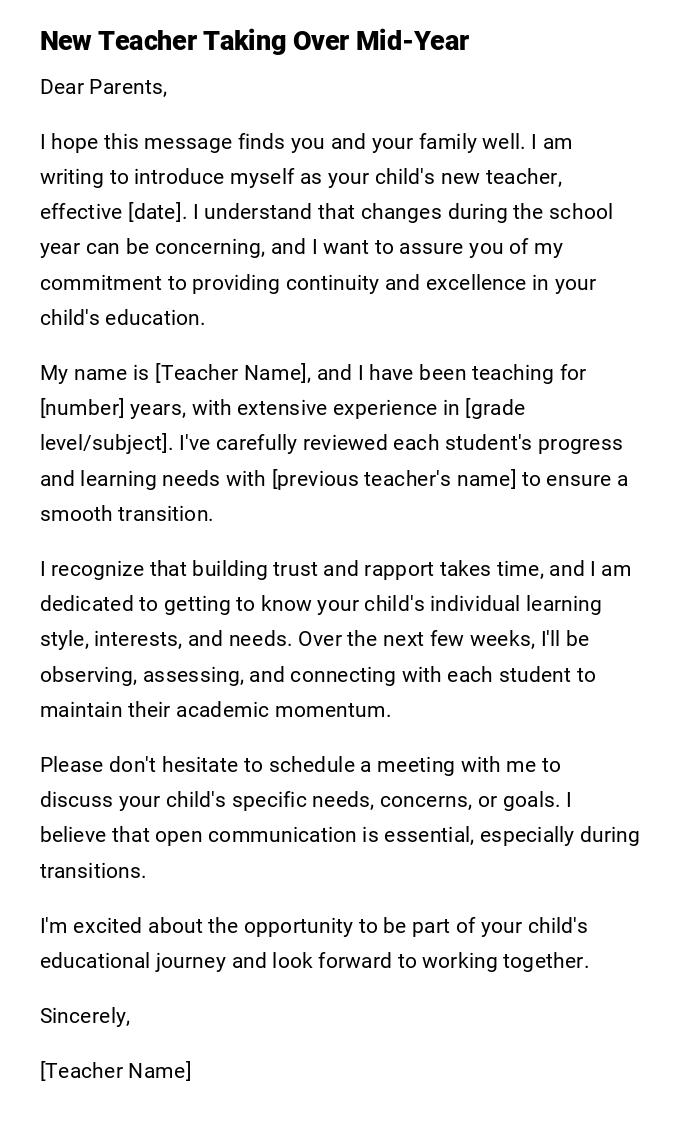
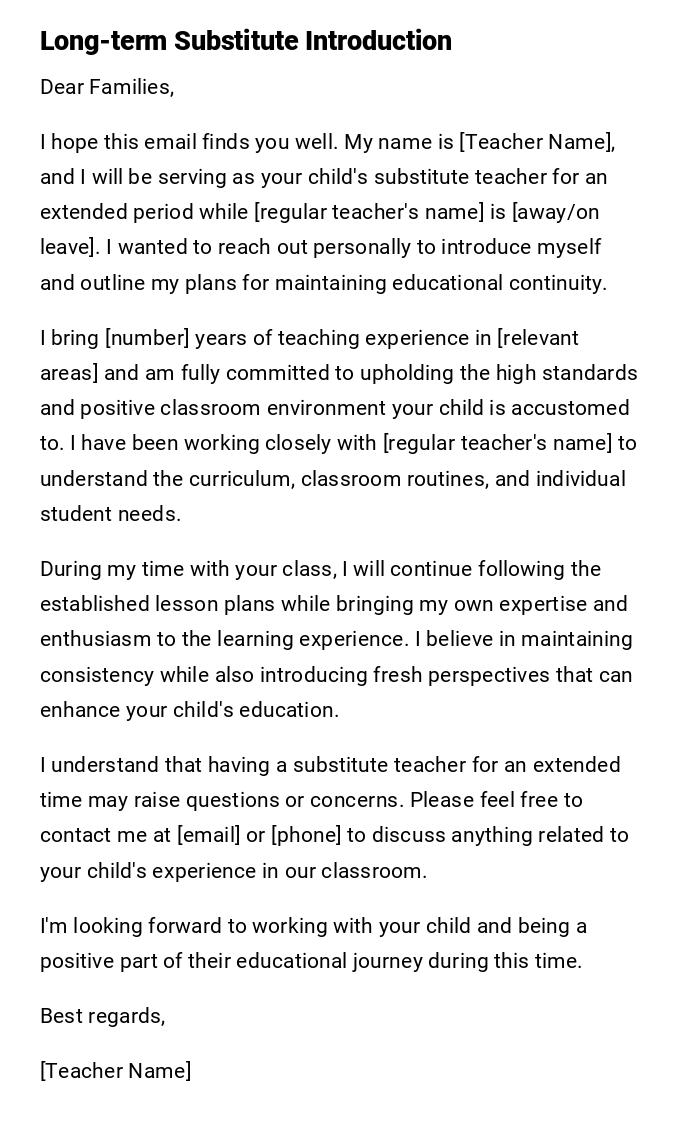
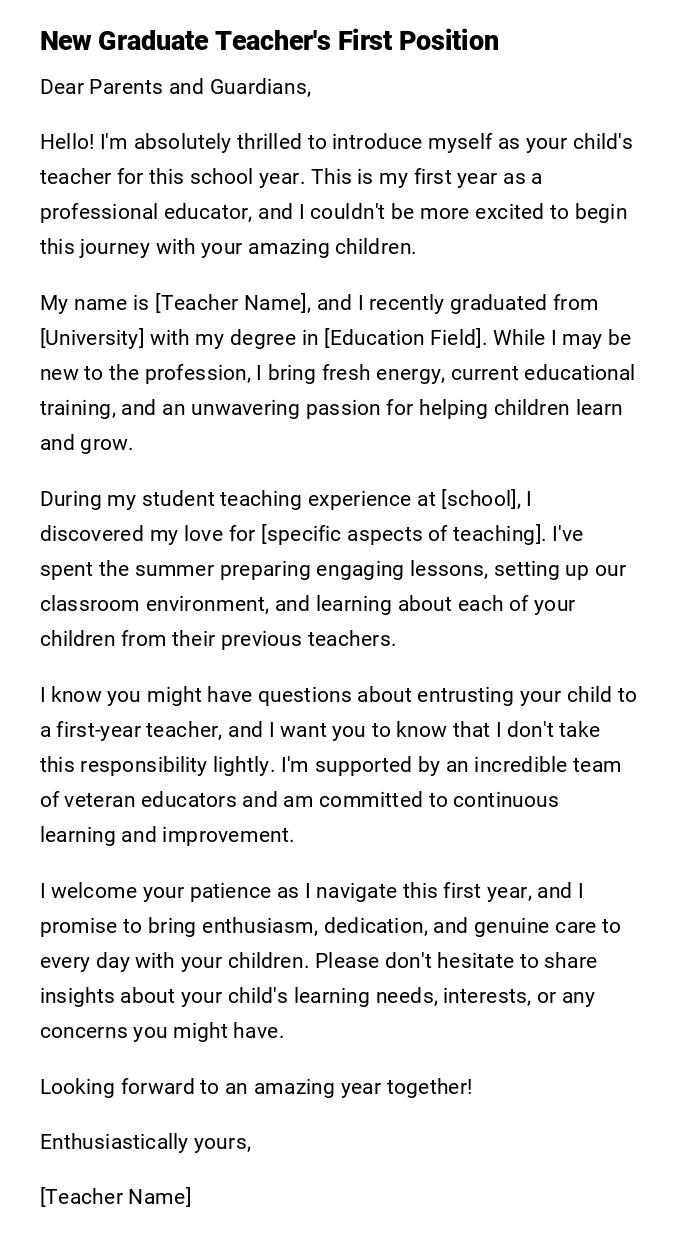
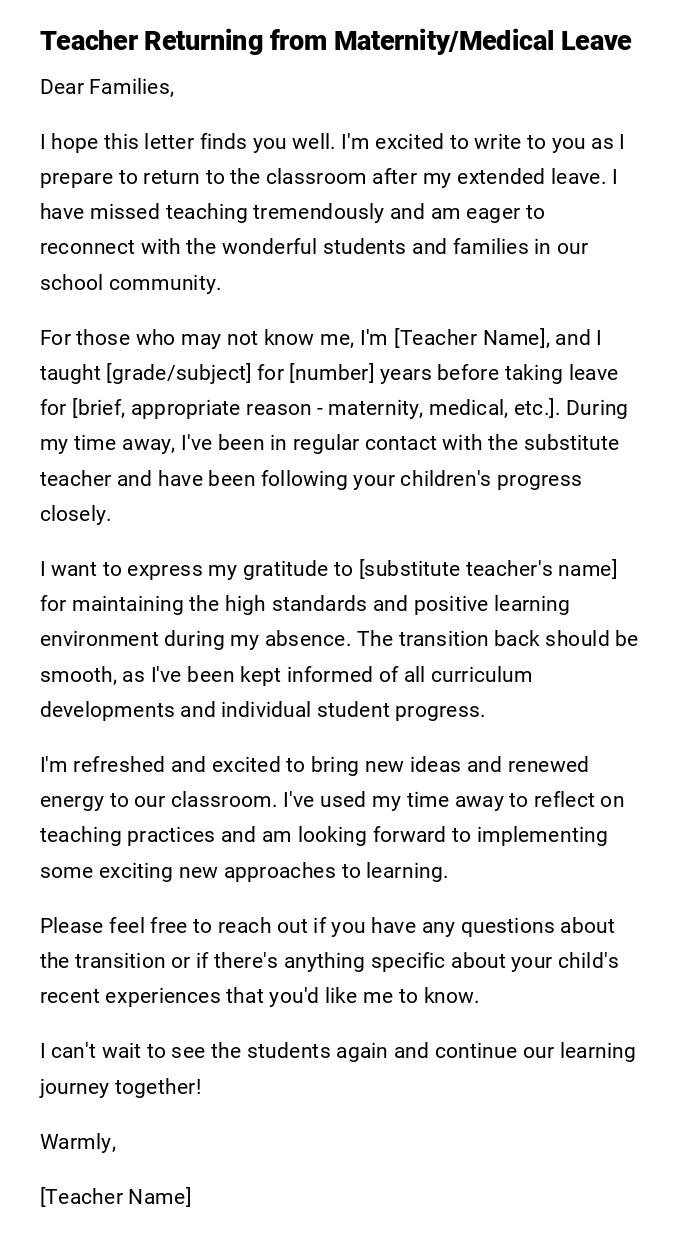
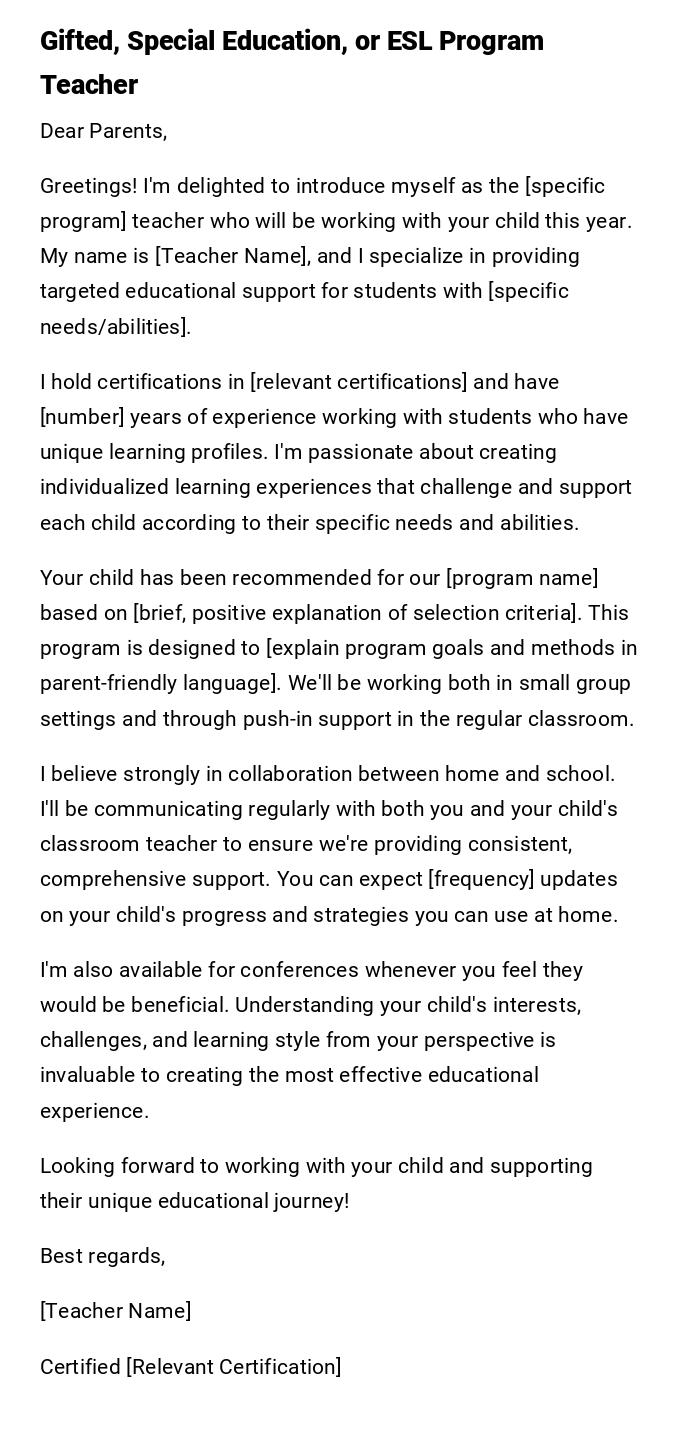
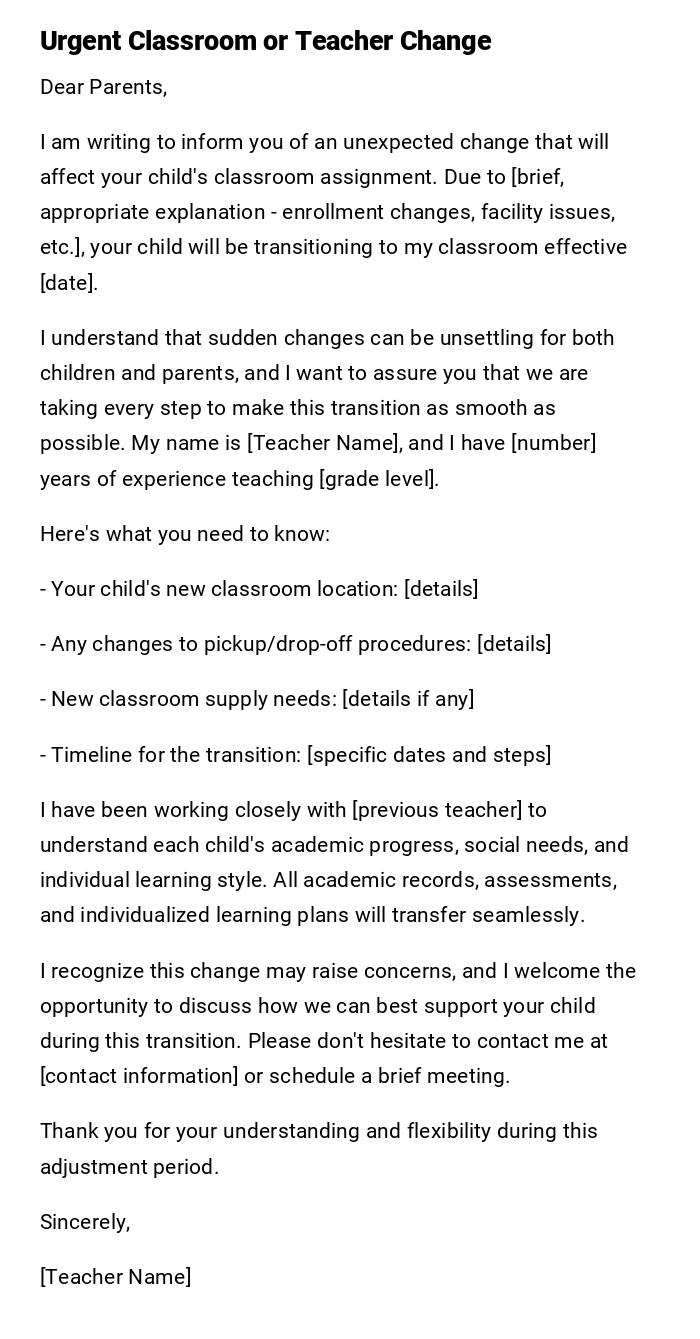

 Download Word Doc
Download Word Doc
 Download PDF
Download PDF